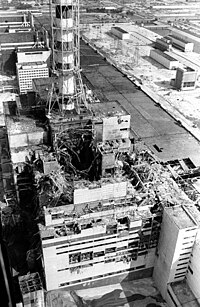
Photo from wikipedia
Abstract One RIA accident, control rod ejection is a design basis accident for LWRs. Hence, it is a postulated event of very low probability, which would have serious consequences if… Click to show full abstract
Abstract One RIA accident, control rod ejection is a design basis accident for LWRs. Hence, it is a postulated event of very low probability, which would have serious consequences if not inherently accounted for in the design of the reactor and the safety systems. In accordance to the regulatory requirement the accident should be analyzed for nuclear reactors. The Westinghouse AP1000 Advanced Passive pressurized water reactor is designed to achieve high safety and performance. Initial core loading of the reactor has three types of UO 2 fuel assemblies with the U235 enrichments namely: 2.35 w/o, 3.40 w/o and 4.45 w/o. In this paper, an alternative core loading is presented in which one-third fuel assemblies is replaced with MOX. The safety performance of the AP1000 during a reactivity insertion accident is investigated by modeling the reactor for the two core loading patterns using QUARK code. QUARK is a 3D neutronic kinetics calculations coupled to core thermal hydraulics code. The required cross-section data for QUARK have been generated using WIMSD5. The aim of the research is to give insights into the UO 2 and MOX fuel behavior during the rod ejection transient. The results of the analysis show that no fuels failure occurs under the transient. The overall performance of UO 2 /MOX core loading has proved to be similar to that of UO 2 core loading with slightly positive effect on the enthalpy and the fuel temperature; the utilization of MOX fuel remains as good as that of UO 2 .
Journal Title: Annals of Nuclear Energy
Year Published: 2017
Link to full text (if available)
Share on Social Media: Sign Up to like & get
recommendations!